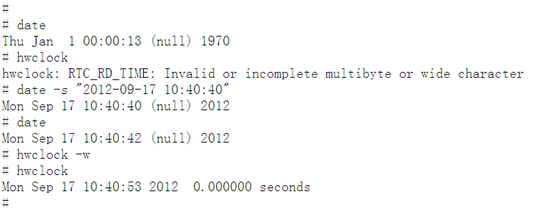rx-8025是片外I2C实时时钟,其应用于9260板卡方法如下。总体思想是配置内核添加驱动(I2C驱动,内核已提供的很完备),板级文件添加设备,添加设备文件以应用程序操作。
1. 配置内核
1)I2C支持(可选择debug信息)。

2)I2Chw选择gpio作为I2C硬件。

3)不选择片上RTT,选择芯片RX-8025。


其中rtc0为设备启动时钟。
2. 添加设备
/arch/arm/mach-at91/board-sam9260ek.c中添加以下语句:
static struct i2c_board_info __initdata ek_i2c_devices[] = {
{
I2C_BOARD_INFO("24c512", 0x50),
.platform_data = &at24c512,
},
/* more devices can be added using expansion connectors */
/* Added for R8025 rtc 20120914 */
{
I2C_BOARD_INFO("rx8025", 0x32),
}
};
----------------------------------------------------------------------------------------------------------
/**
* I2C_BOARD_INFO - macro used to list an i2c device and its address
* @dev_type: identifies the device type
* @dev_addr: the device's address on the bus.
*
* This macro initializes essential fields of a struct i2c_board_info,
* declaring what has been provided on a particular board. Optional
* fields (such as associated irq, or device-specific platform_data)
* are provided using conventional syntax.
*/
#define I2C_BOARD_INFO(dev_type, dev_addr)
.type = dev_type, .addr = (dev_addr)
/driver/rtc/rtc-s1370.c
static const struct i2c_device_id ds1307_id[] = {
{ "ds1307", ds_1307 },
{ "ds1337", ds_1337 },
{ "ds1338", ds_1338 },
{ "ds1339", ds_1339 },
{ "ds1340", ds_1340 },
{ "m41t00", m41t00 },
{ "rx8025", rx_8025 },
{ }
};
注:I2C_BOARD_INFO()中,第一项为type,第二项为addr,
dev_type必须与驱动中i2c_device_id数组中name匹配,其也是I2C设备与驱动匹配的基础。
添加硬件相关引脚支持(总线支持),arch/arm/mach-at91/at91sam9260_devices.c
/* -------------------------------------------------------------------- * TWI (i2c) * -------------------------------------------------------------------- */ /* * Prefer the GPIO code since the TWI controller isn't robust * (gets overruns and underruns under load) and can only issue * repeated STARTs in one scenario (the driver doesn't yet handle them). */ #if defined(CONFIG_I2C_GPIO) || defined(CONFIG_I2C_GPIO_MODULE) static struct i2c_gpio_platform_data pdata = { .sda_pin = AT91_PIN_PA23, .sda_is_open_drain = 1, .scl_pin = AT91_PIN_PA24, .scl_is_open_drain = 1, .udelay = 2, /* ~100 kHz */ }; static struct platform_device at91sam9260_twi_device = { .name = "i2c-gpio", .id = -1, .dev.platform_data = &pdata, }; void __init at91_add_device_i2c(struct i2c_board_info *devices, int nr_devices) { at91_set_GPIO_periph(AT91_PIN_PA23, 1); /* TWD (SDA) */ at91_set_multi_drive(AT91_PIN_PA23, 1); at91_set_GPIO_periph(AT91_PIN_PA24, 1); /* TWCK (SCL) */ at91_set_multi_drive(AT91_PIN_PA24, 1); i2c_register_board_info(0, devices, nr_devices); platform_device_register(&at91sam9260_twi_device); } #elif defined(CONFIG_I2C_AT91) || defined(CONFIG_I2C_AT91_MODULE) static struct resource twi_resources[] = { [0] = { .start = AT91SAM9260_BASE_TWI, .end = AT91SAM9260_BASE_TWI + SZ_16K - 1, .flags = IORESOURCE_MEM, }, [1] = { .start = AT91SAM9260_ID_TWI, .end = AT91SAM9260_ID_TWI, .flags = IORESOURCE_IRQ, }, }; static struct platform_device at91sam9260_twi_device = { .name = "at91_i2c", .id = -1, .resource = twi_resources, .num_resources = ARRAY_SIZE(twi_resources), }; void __init at91_add_device_i2c(struct i2c_board_info *devices, int nr_devices) { /* pins used for TWI interface */ at91_set_A_periph(AT91_PIN_PA23, 0); /* TWD */ at91_set_multi_drive(AT91_PIN_PA23, 1); at91_set_A_periph(AT91_PIN_PA24, 0); /* TWCK */ at91_set_multi_drive(AT91_PIN_PA24, 1); i2c_register_board_info(0, devices, nr_devices); platform_device_register(&at91sam9260_twi_device); } #else void __init at91_add_device_i2c(struct i2c_board_info *devices, int nr_devices) {} #endif
3. 创建设备文件
在根文件系统中,创建设备文件
mknod /dev/rtc0 c 10 135
注:rtc0与内核配置启动时钟吻合。
4. 编译内核,查看启动信息。

注:i2c设备驱动需支持两层:适配器(bus,主端),设备(从端),两者需要不同的驱动。
GPIO-based bitbanging是I2Cbus总线支持,芯片也需要单独的驱动。
BSP除了要添加芯片设备外(I2C_BOARD_INFO),还要增加CPU端适配器的支持。